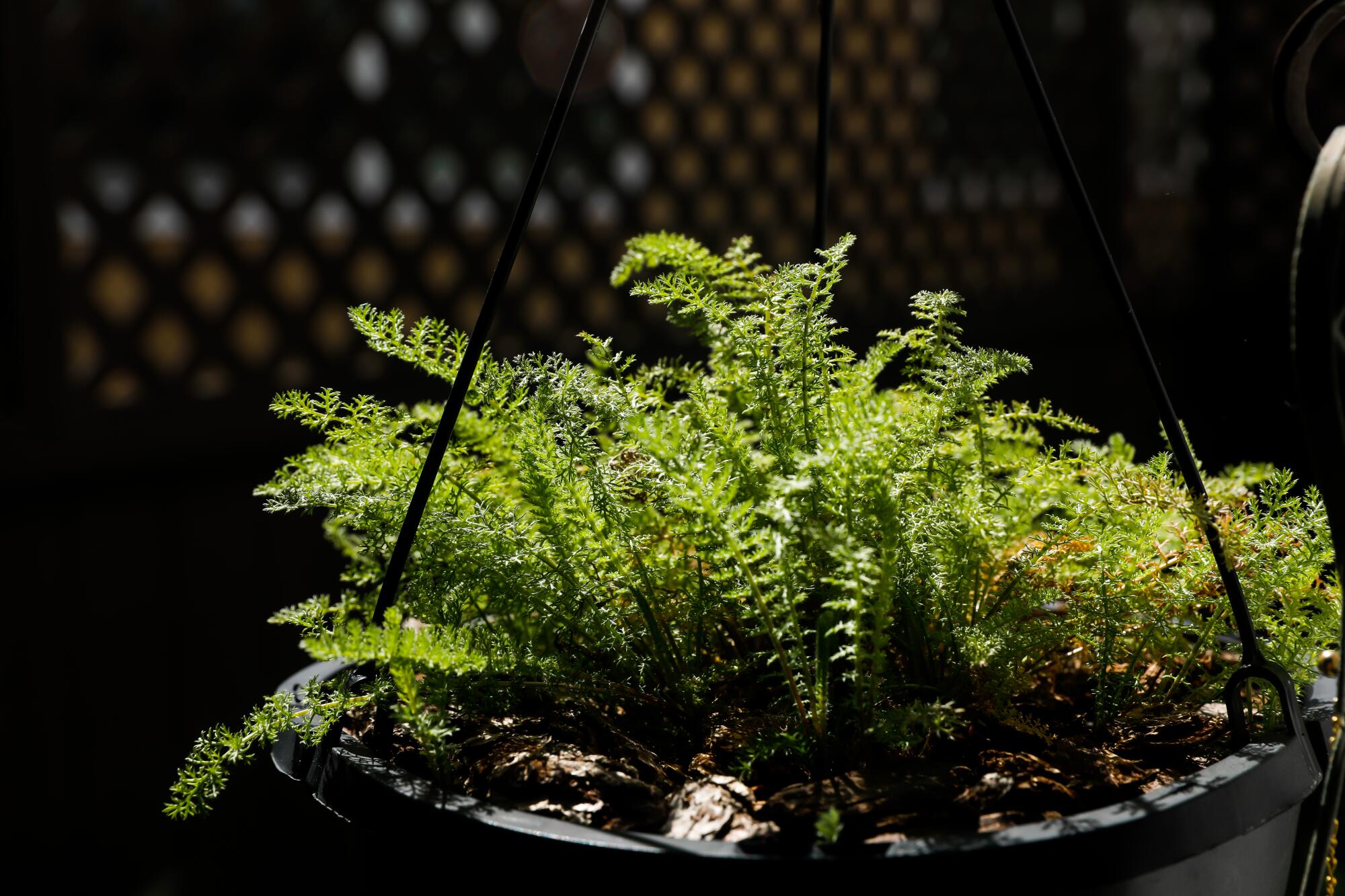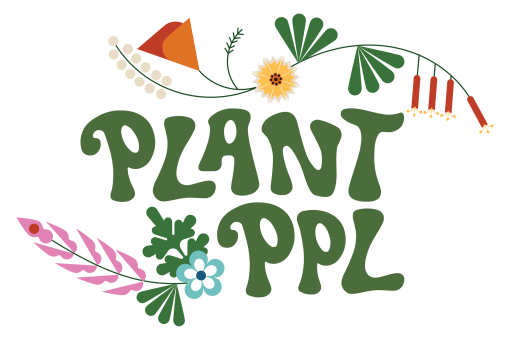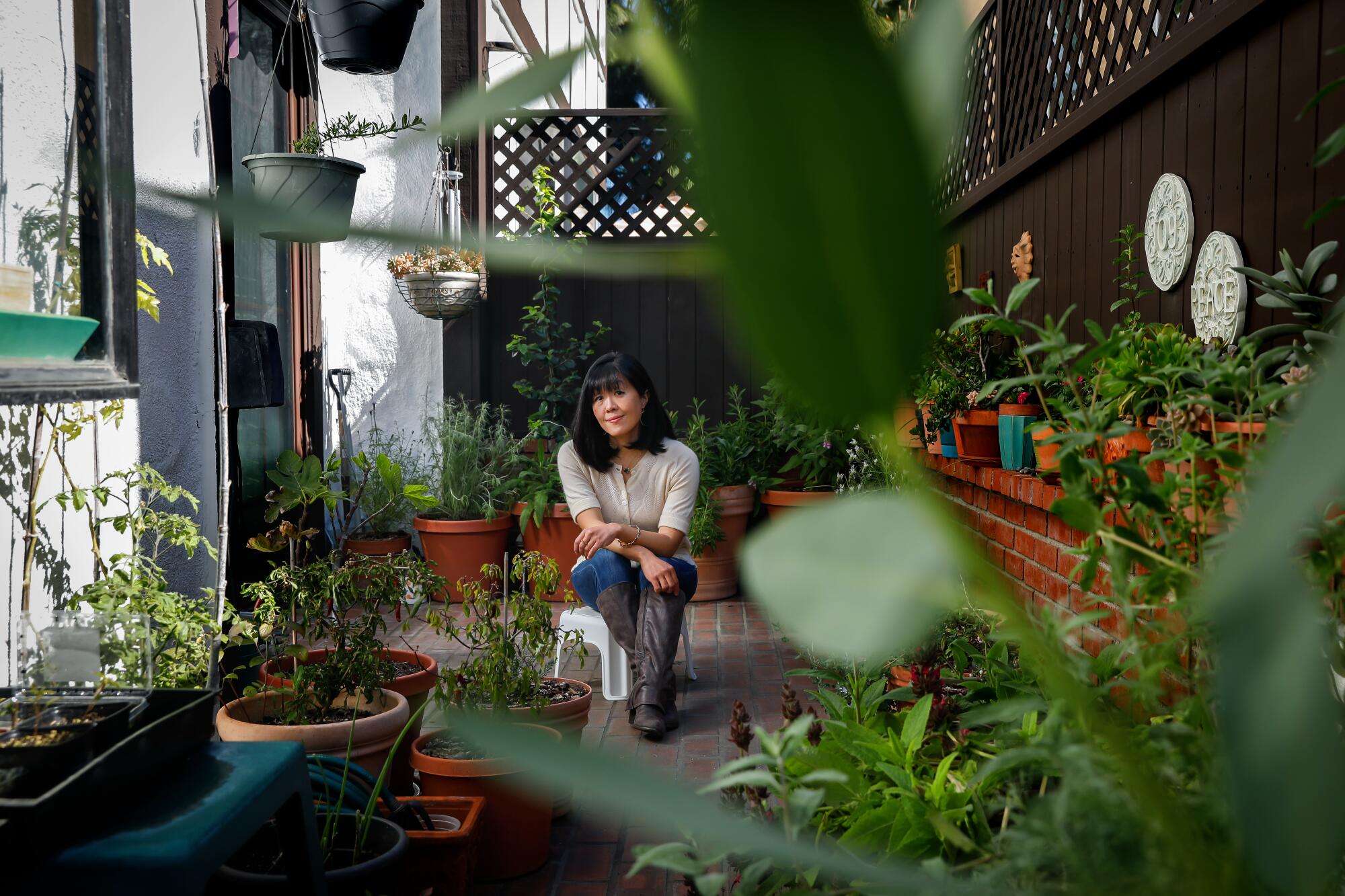
Barbara Chung may have the tiniest habitat garden in Los Angeles — some 200 mostly native plants in pots on her 7-by-20-foot townhouse terrace — and she’s happy to erase any doubts about whether patio habitats can really support wildlife.
Right now, though, all she wants to talk about is the hummingbird family nesting outside her living room window. She’s set up a ladder to better watch their nest, and when she’s not perched there, she’s running to the back of her home to watch the mama hummingbird visit her habitat garden for nectar to feed her two chicks.
In our Plant PPL series, we interview people of color in the plant world. If you have suggestions for PPL to include, tag us on Instagram @latimesplants.
The mama visits several flowers, but her favorites are the thick magenta blooms of hummingbird sage (Salvia spathacea) and the violet, deep-throated flowers of fragrant pitcher sage (Lepechinia fragrans).
Those are Chung’s favorites, too, and they grow particularly well among the plants arranged in neat rows on her south-facing patio. Every inch of the perimeter is covered with plastic and ceramic pots brimming with buckwheat and verbena, dudleya, penstemon and black sage. There’s even a small manzanita with its dainty fairy bell flowers and a fat bush poppy erupting with lemon-yellow blooms. And there are more plants on a ledge above.
It’s like the entirety of her roughly 140-square-foot patio is a polite but defiant reminder that sometimes the “experts” — like the ones who told her she needed land to grow native plants — are wrong.
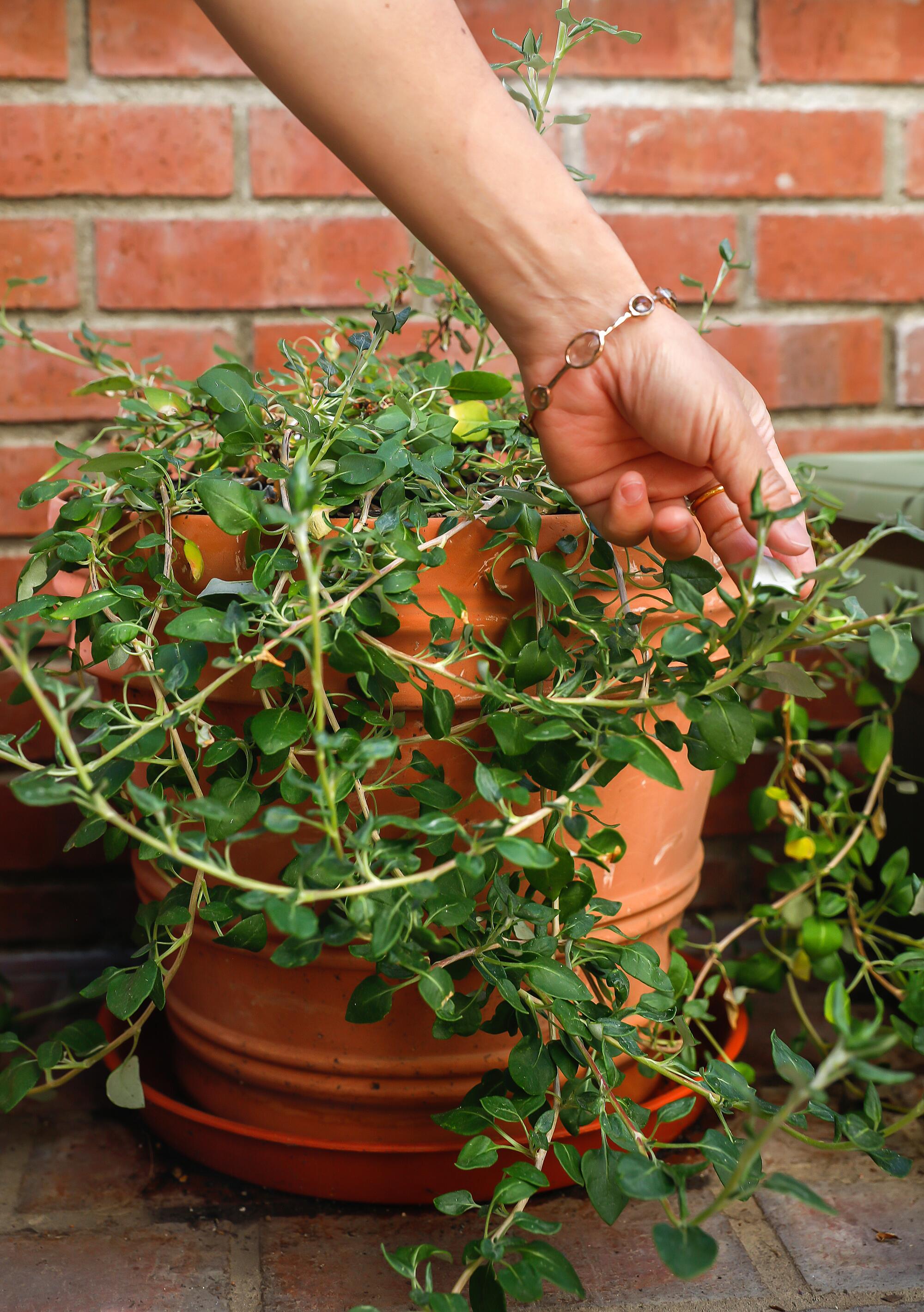
“I decided that couldn’t be right,” she said. “And I would find a way to have native plants thrive in containers.”
Chung works as a business strategy advisor, but she describes herself as a poet, writer and naturalist on the bio for her two published volumes of poetry, “Heart” and “Sunlight,” and lists her California naturalist certification on the same line as her Renaissance literature degree from Harvard and MBA from UCLA. One of her final projects for her naturalist certification was writing short poems about plants native to Southern California, which she included in a digital book — “The Princess Troll’s Guide to Plants of Southern California” — about a princess who discovers her surprising affinity with the natural world after walking barefoot in the woods.
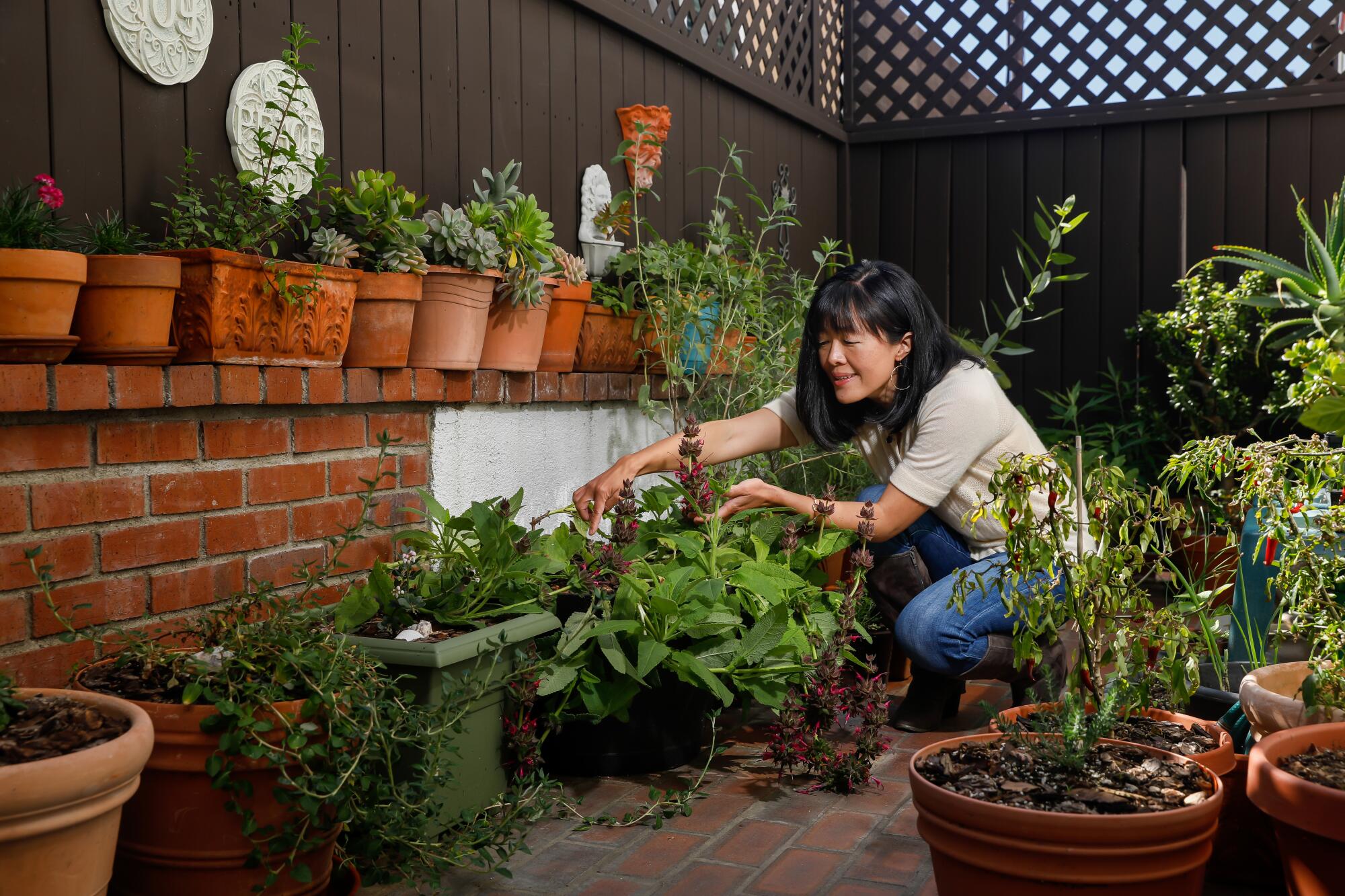
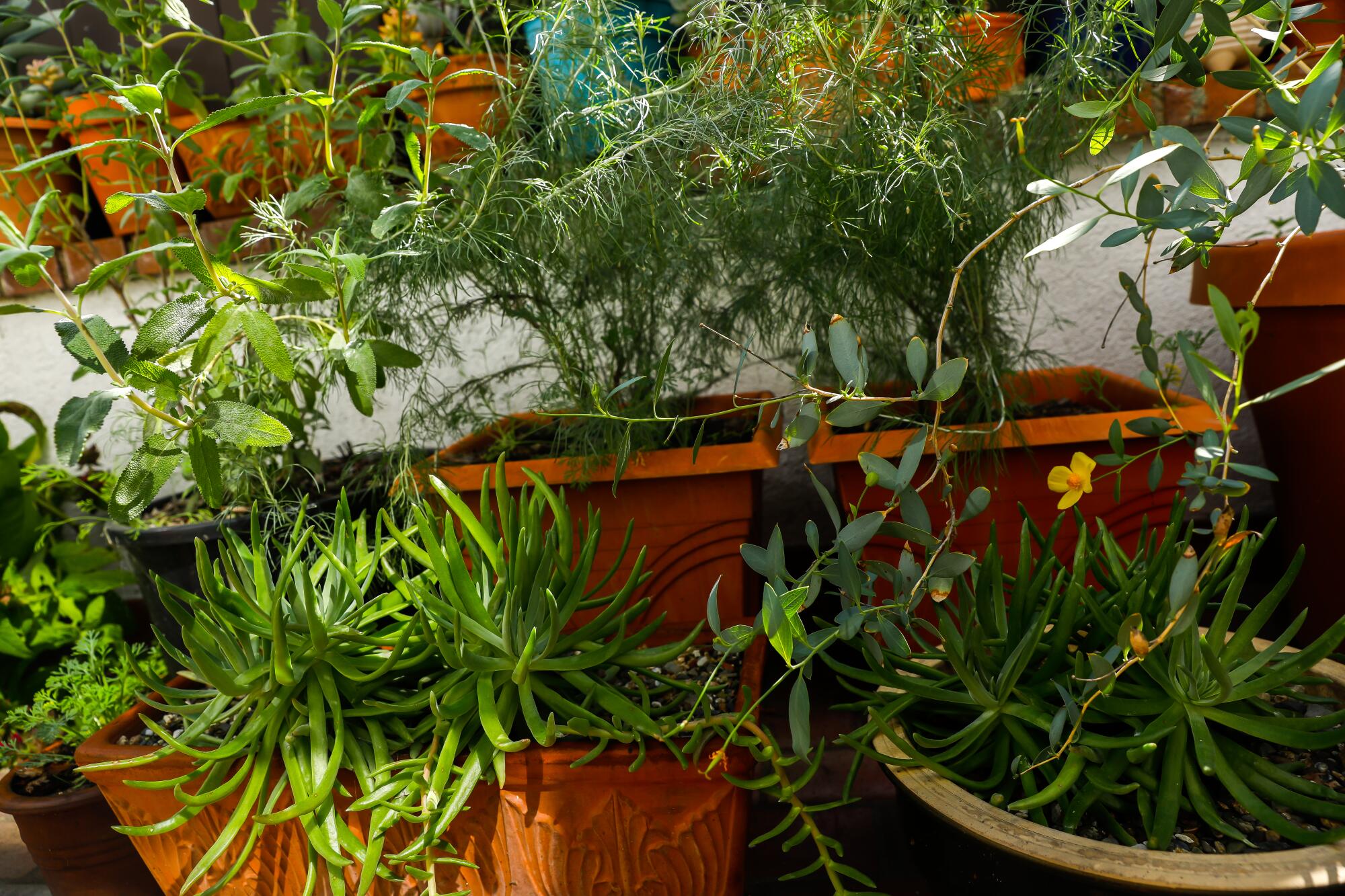
Chung became enamored with native plants in 2019, when she volunteered to help with a TreePeople habitat restoration project in Topanga. She was coming out of a period of intense grief after losing her beloved golden retriever, Ella, to cancer in 2018. Volunteering was a big part of her life with Ella; they used to make regular visits to local hospitals to give comfort to terminal patients. After Ella died, Chung couldn’t face going back into hospitals. She found another way to volunteer by helping organizations restore habitat.
She didn’t know much about plants, but the work sounded interesting and useful, she said. Then, the night before the project was to begin, she found herself transfixed by an article in The Times about efforts to resurrect the language of the Tongva, one of Southern California’s native peoples.
“It was a beautiful piece of work, and I was so astonished I hadn’t known about any of this before. I’ve lived in Boston, traveled to Europe, but for the first time I realized how much history there is here, in Los Angeles; a very ancient history that was nearly wiped out,” Chung said.
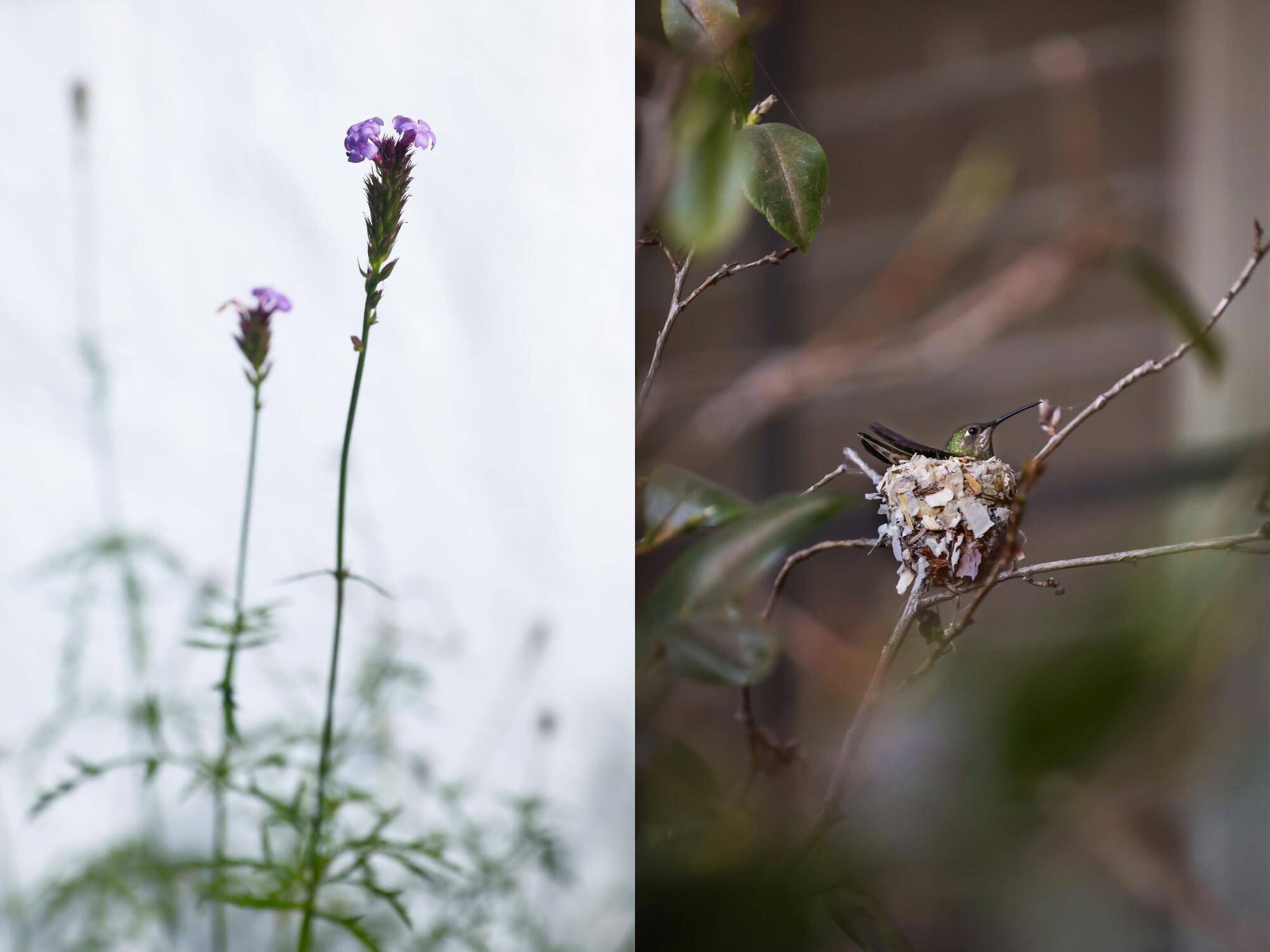
“The next day, I was telling everybody about this article. One of the TreePeople staff heard me and pointed out one of the plants we were working near — giant wild rye. He said the Tongva people used the plant in a variety of ways. The leaves are very sharp, so they used them to cut things. It took all that history that was so new to me and brought it right into the present with a living plant. … I literally fell in love with native plants in that instant.”
Chung began working with other restoration groups, such as the Santa Monica Mountains Fund, and the more she learned about native plants, the more she wanted to try growing her own. “People would talk about their native plant gardens, and I’d say, ‘I have no land, I just have a patio,’ and they would say, ‘Well, native plants really belong in the ground.’ I think they were thinking about oak trees and walnuts, with their deep taproots that need a lot of space. I thought, ‘I understand what you’re saying; you only want what’s best for the plants,’” she said.
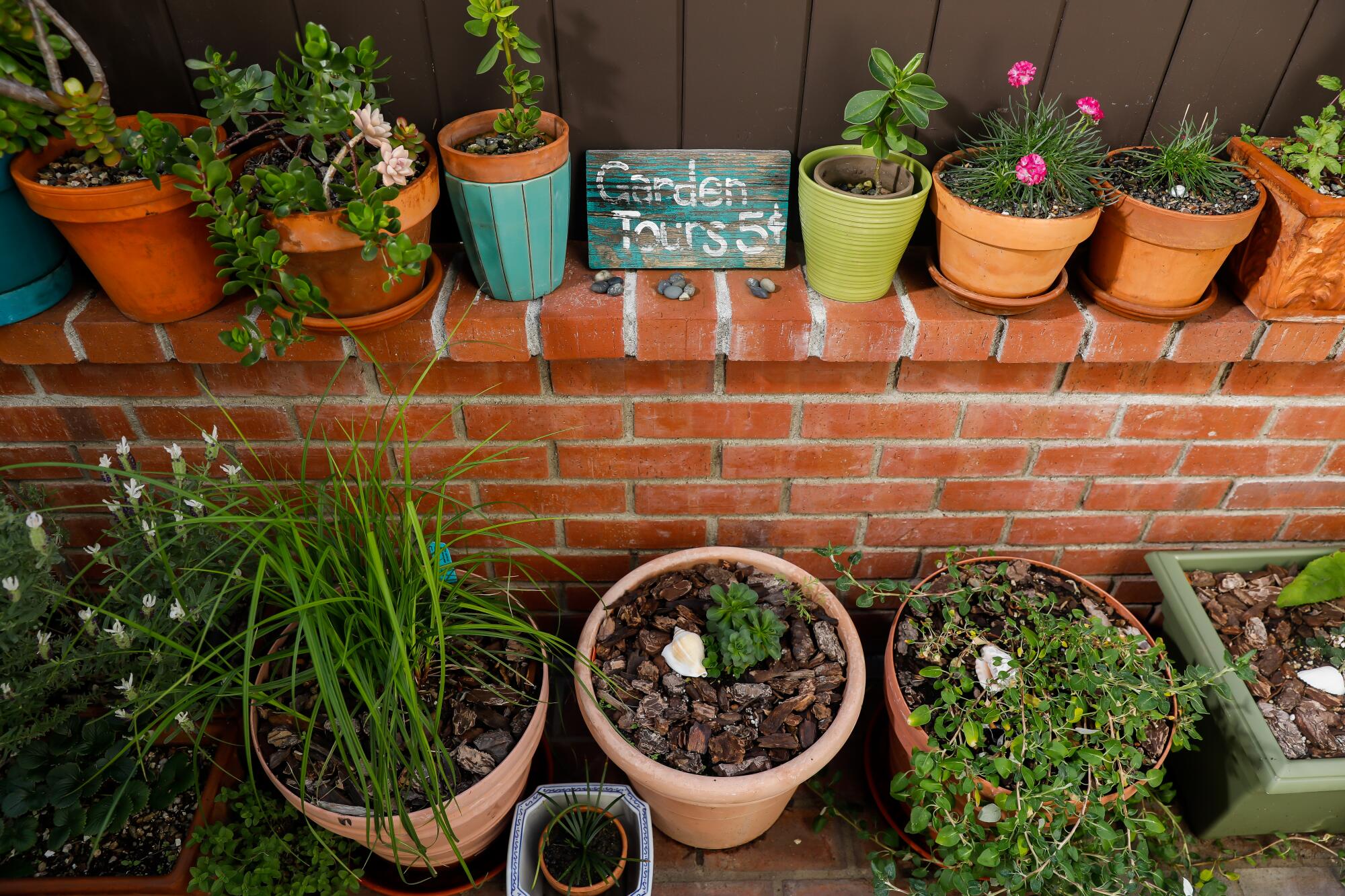
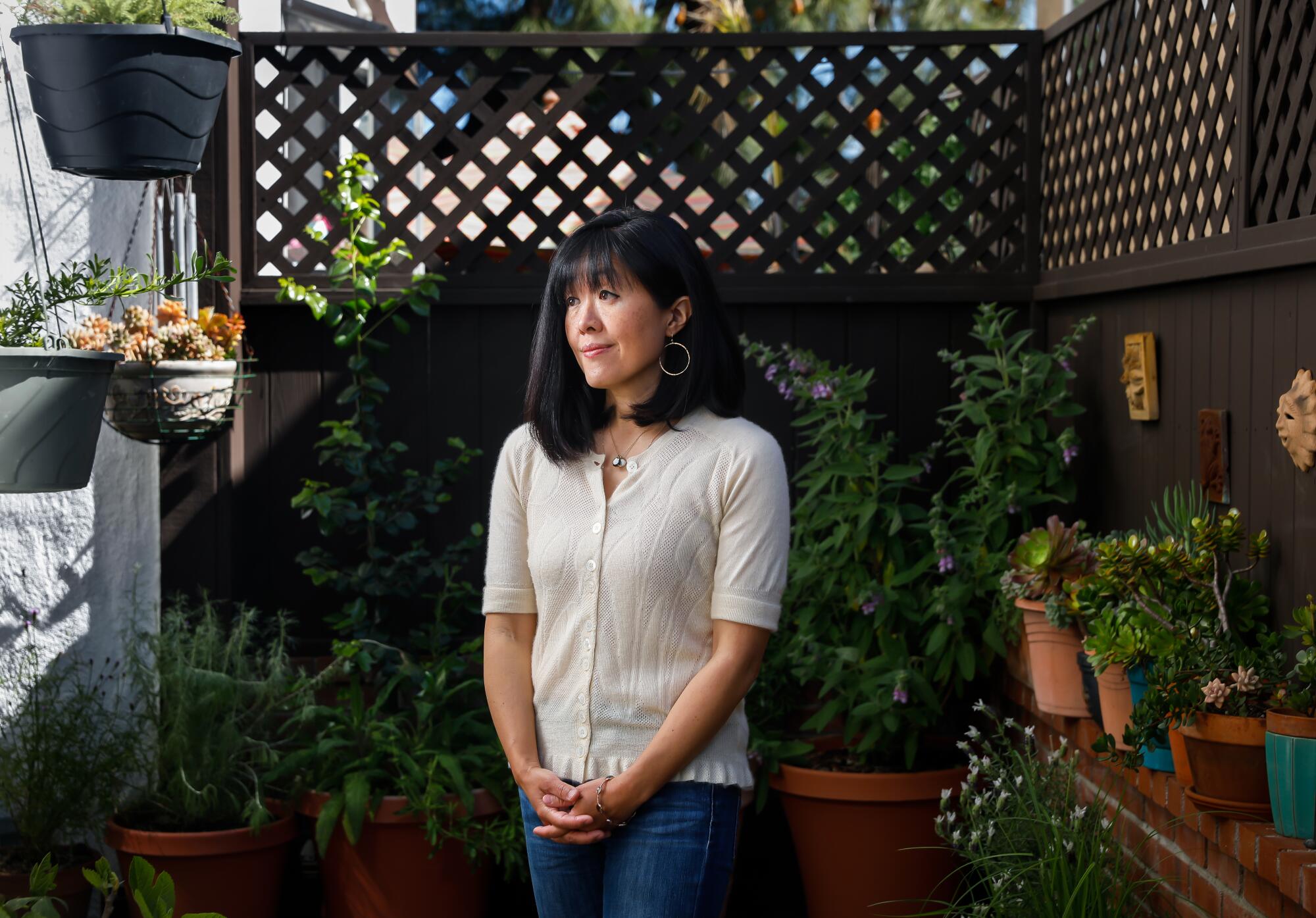
“But the underlying assumption was you have to have ground in order to have native plants, and in a place like L.A., to have ground you have to have privilege. I’m not begrudging people with privilege, but most people don’t live like that in L.A. or most other urban centers. It just felt morally wrong to me that you have to have land to have these plants. So I thought, ‘I’m going to figure this out.’”
She began to experiment in 2020, and, as you may have already guessed, Chung never does anything halfway. She kept volunteering at places where she could learn about native plants, especially after she found she could get three native plants for free if she spent at least two hours volunteering at the Santa Monica Mountains Fund Native Plant Nursery on Fridays or Saturdays.
Ever the student, she also enrolled in the UC California Naturalist Program to learn more about California’s natural world “and how all the elements link together — plants, geology, animal life,” she said. “The second goal is you have to be able to teach others about it.” The certification “lends me some more credibility, I hope. I realize I’m an amateur, but I’m a serious amateur.”
As for sharing her knowledge, she’s been giving talks discussing her successes and failures in growing native plants in containers, always reminding people that they can support nature without a yard.
“I’ve lived in this townhouse for 15 years, just a block from Wilshire, and I never saw a monarch (butterfly) until I started putting in native plants in 2021,” she said. “It’s just been so neat seeing all the pollinators and birds — dark-eyed junkos, house finches and a pair of mourning doves who nested on the roof and pecked seeds from the flowers. They came to eat at real specific times and flew over my head if I walked outside around 5 p.m. I’d never been bullied by a dove, but I loved that they felt entitled to my space.”
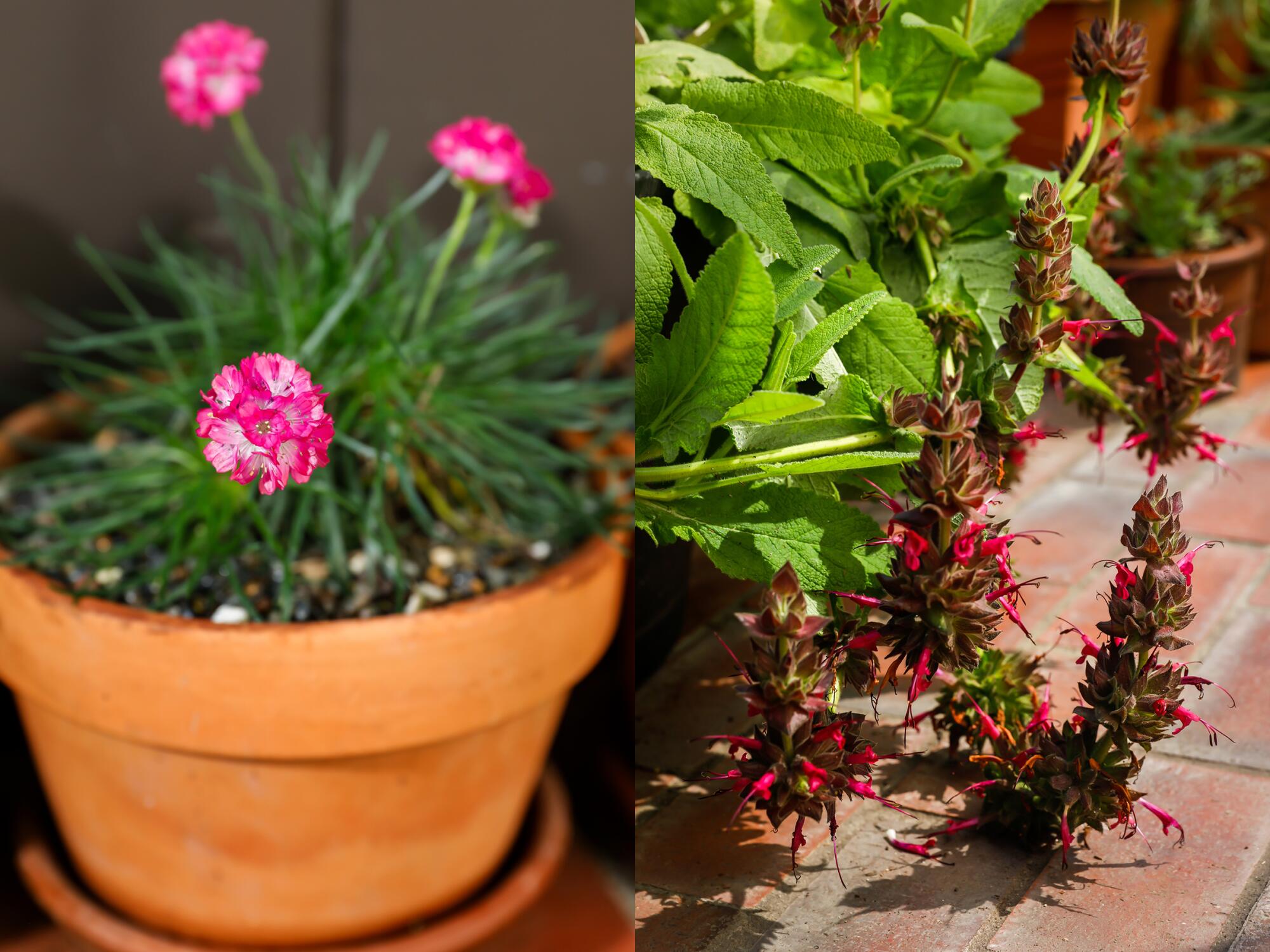
Here are Chung’s tips for starting your own container habitat garden of native plants:
1. “Choose plants that are easy and forgiving,” — like common yarrow — that grow easily almost everywhere, or pick plants adapted to your specific climate. Chung said she learned quickly that desert plants were unhappy with the moisture in Santa Monica. “I discovered that anything with ‘sea’ in its name did well here, like sea cliff buckwheat (Eriogonum parvifolium), seaside daisy, thrift seapink and seaside heliotrope.” Her attempts to grow small manzanitas failed with three different varieties until she learned about Big Sur manzanita (Arctostaphylos edmundsii ‘Big Sur’), a short shrub discovered growing along the coast. Now it’s blooming happily in a pot outside her kitchen window.
2. “Choose plants that mean something to you personally.” Sentiment is not usually recommended in landscaping, but it’s been one of Chung’s guiding principles. One of her first plants was an island bush poppy, because its bright yellow flowers were featured on the cover of her poetry book “Sunlight.” She’s created an aromatherapy section of her garden because the intense fragrance of so many native plants makes her feel good. And she’s keeping a watchful eye on a healthy 4-foot tree that sprouted in a large pot where she had casually thrown a Catalina cherry pit. The tree (Prunus ilicifolia ssp. lyonii) can grow over 30 feet tall in the wild, but Chung said she can’t bear to tear it out. “I’m hoping it will bonsai itself.”
3. “Choose a high percentage of evergreen plants that bloom at different times of the year.” Many native plants go dormant in the summer, which is not a good look for a terrace, or helpful to pollinators, she said. And bloom times are especially important in small spaces, so you can be sure something is always providing food for the pollinators and pleasure for the humans.
4. “Use goodquality potting soil.” Native plants prefer native, nonenriched soils in the wild and can send their roots deep into the ground for water, but Chung discovered that containers dry out quickly and her plants did better when she used potting soils that retained moisture. Make sure the soil is damp when you plant, she said, rather than putting the plant in dry soil and watering afterwards. And use mulch or rocks on top of the soil to help preserve moisture.
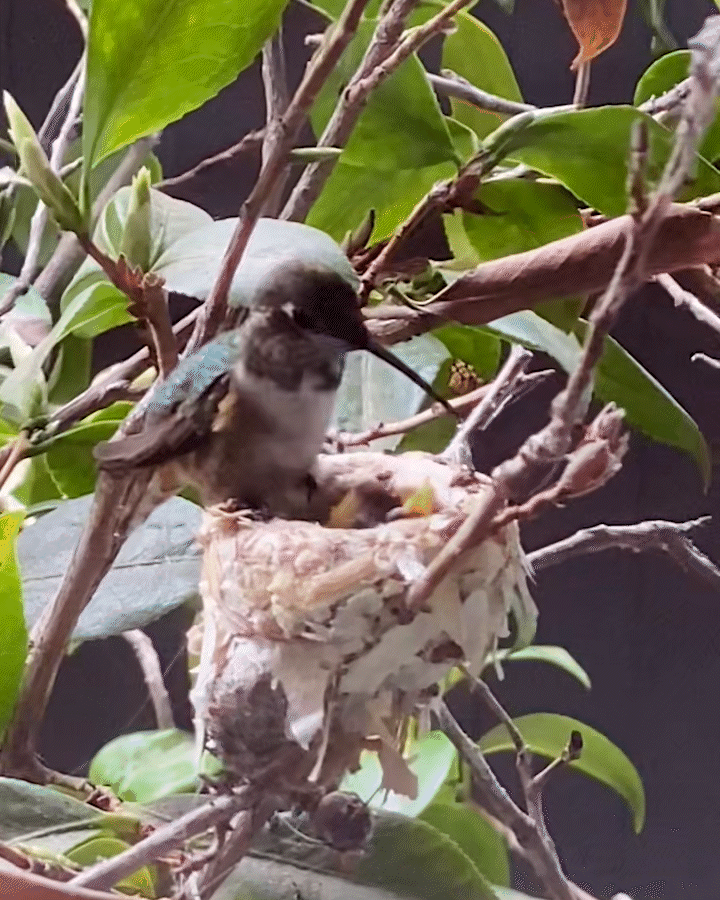
5. “Amend the soil a couple of times a year.” Native plants rarely need feeding when they’re planted in the ground, but in containers, any nutrients in the soil are being leached out with every watering. Chung said her plants do better when she adds coffee grounds, cinnamon and worm castings to the soil every six months or so.
6. Water deeply but infrequently — Chung says roughly every 10 to 14 days for her garden — and never during a heat wave. Many plants shut down during high heat, such as several days over 100 degrees, and aren’t able to absorb any water, so leaving them in a pot of warm wet soil could lead to root rot. Keep an eye on the forecast, water your plants deeply before a heat wave and then leave them alone until the temperatures drop.
7. Volunteer with native plant organizations to learn more. “There’s no substitute for learning from real native plant experts and getting your hands in the soil,” Chung said. “I’ve learned a ton from volunteering at the Santa Monica Mountains Fund Native Plant Nursery.”
8. A final note about habitats: Nature can bring joy and heartbreak to your garden. A couple of weeks after the hummingbird chicks hatched, Chung came home to discover the nest was empty. It was too early for the chicks to have flown away, she said, and she suspects the crows lingering near the nest devoured the babies while the mother was away. The loss was devastating, and Chung said she’s had to think hard about the wisdom of creating a patio habitat. “I’m still processing the lessons from this experience,” she wrote in a text. “It was such a blow. But at the same time, there was such radiant joy in the moment. I wouldn’t trade that for anything.”
